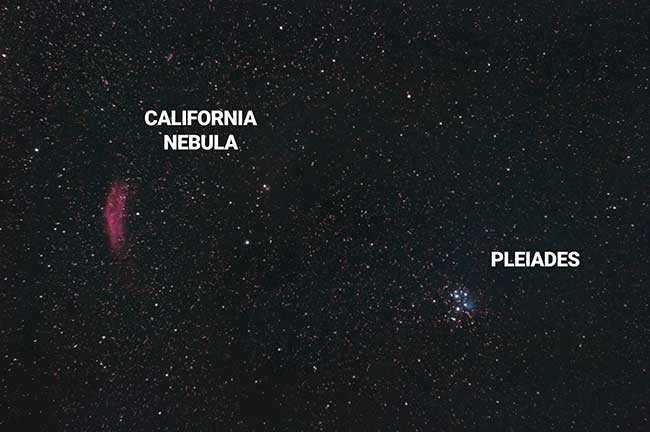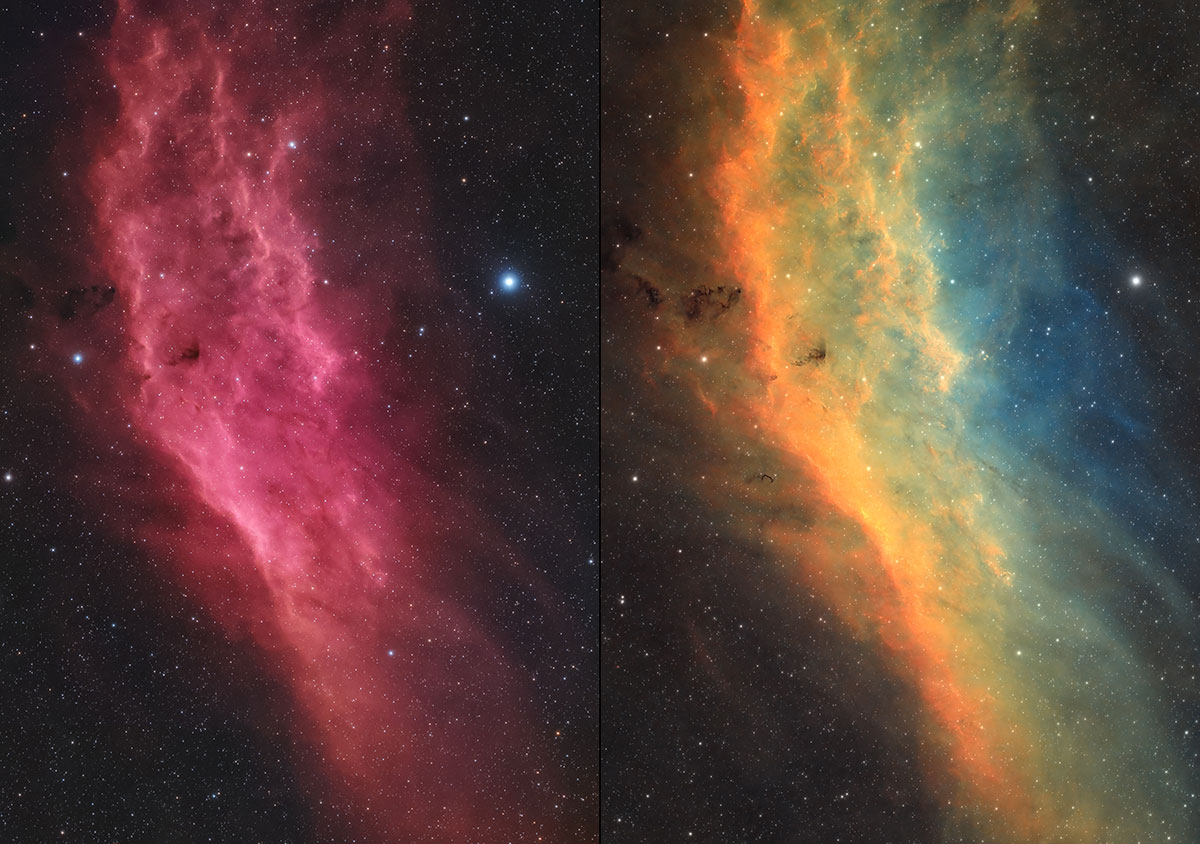The California Nebula
The California Nebula (NGC 1499) is an intense hydrogen emission nebula located in the constellation Perseus. It lies 1,500 light years away from Earth and gets its nickname due to its striking resemblance in shape to the US state of California.
With an apparent magnitude of 6, this deep-sky object is challenging to observe visually through a telescope eyepiece. Under a dark, moonless sky it is possible to observe this diffuse emission nebula, but it will not appear as it does in the photos shared on this page.
Its hydrogen composition and large apparent size (2.5°) make the California Nebula a fantastic deep-space object to photograph using a camera and telescope. The California Nebula is one of the first emission nebulae I photographed after modifying my DSLR camera for astrophotography in 2014.
The California Nebula. Trevor Jones.
The image above was captured using a ZWO ASI2600MM Pro dedicated astronomy camera, through a compact refractor telescope. To see the latest astrophotography setup I use for photos like this, please visit the astrophotography equipment page.
The California Nebula
The California Nebula is a large, long nebula as far as deep-sky objects go. The nebula is 60 light-years across, or 2.5°. For reference, this is about 5 times the length of the full moon in the sky.
To backyard astronomers, NGC 1499 is associated with the changing of seasons from summer to fall. At mid-northern latitudes, the best time to observe and photograph the California Nebula is between September – February.
The image below shows the bright deep-sky objects in the constellation Taurus and Perseus including the California Nebula near the center of the frame.
Deep-sky objects in the constellation Taurus and Perseus. Trevor Jones.
This nebula’s signature red glow is thanks to the nearby star, Xi Persei, seen at the lower right side of my image. This luminous blue star (also known as Menkib) is a blue giant that is over 12,000 times brighter than the sun. This massive star ionizes the hydrogen atoms in the California Nebula and is responsible for creating this iconic deep-sky object in our night sky.
The image of the California Nebula below was captured using a modified DSLR camera and a Rokinon 135mm F/2 lens. The focal length of this lens is a great fit for NGC 1499 and showcases the massive apparent size of this nebula from our vantage point on Earth.
The California Nebula using a 135mm Camera Lens.
Location and Nearby Deep Sky Objects
The California Nebula’s isolated location in Perseus really makes it stand out in a long exposure wide-angle image. It is the only bright nebula in this area of Perseus and is often included in a wide-angle photo that includes the Pleiades.
To capture an image of this object at this magnification, I used a DSLR camera with a 50mm camera lens attached. The camera and lens were mounted to a star tracker mount (iOptron SkyTracker Pro) that matches the apparent rotation of the night sky for long exposure photography.
The California Nebula and Pleiades are roughly 12 degrees apart in the night sky
The image above shows the California Nebula in Perseus and the Pleiades in Taurus. These are two contrasting nebula types, with California being an emission nebula, and the Pleiades, a star cluster and reflection nebula.
Over the years, I have photographed the California Nebula using a variety of different camera lenses and telescopes. On this page, I’ll share some of the images I have taken, and what to expect when capturing this beautiful cosmic cloud.
Astrophotography
The process of photographing the California Nebula (or any other deep-sky object) involves taking a series of long-exposure images. This can be accomplished using a traditional DSLR camera, a dedicated astronomy camera, or a CCD.
A DSLR camera that has been modified for astrophotography will make a monumental difference in the amount of signal (light) your camera can collect. This is because the default internal IR cut filter inside of your DSLR blocks important wavelengths of light.
A telescope or telephoto camera lens will magnify this object, revealing its unique and beautiful features. The image below shows contrasting views of the California Nebula. The background image was captured with a DSLR and wide-angle (18mm lens), while the inset is the view through a small refractor telescope.
A wide-angle nightscape is a great way to illustrate the California Nebula’s rather unique, isolated position in the night sky, while a deep sky image through a telescope will unlock its feathery details.
A proven method of success for capturing the California Nebula is to collect light using a narrowband hydrogen-alpha filter. When you combine the enhanced contrast and isolation possibilities of an H-Alpha (Ha) filter with a camera capable of collecting light in this wavelength, you can create some exceptional photos.
A particular technique I like to use when photographing the California Nebula is to create a HaRGB composite. This is an especially attractive option for DSLR astrophotographers. Here is a look at the California Nebula captured in H-Alpha.
Isolating the California Nebula to the Ha wavelength showcases the fine details of this nebula by filtering out light pollution and concentrating the signal collected by the camera sensor. The Astronomik 12nm H-Alpha filter was the first narrowband filter I purchased for my DSLR camera, and I highly recommend it.
Image Processing
There are several ways to create a color image of the California Nebula. A popular method is to collect narrowband details (a process called ‘narrowband imaging‘) of your target through multiple filters and map them to the RGB channels to build a false-color image. It is best to use a monochrome astronomy camera to do this, as the signal in each exposure will be stronger than it is with a color camera.
Another technique is to simply capture this nebula in true-color (broadband) RGB. This creates an image with an accurate rendition of colors including the many stars surrounding NGC 1499. To boost the signal of your image, applying additional narrowband data in H-Alpha is recommended, as outlined in the HaRGB tutorial I mentioned earlier.
Applying images of the California Nebula captured in the Hydrogen Alpha wavelength to a color image in Photoshop.
Adobe Photoshop allows you to easily align images captured in isolated wavelengths of light to their own color channels. Mapping the H-Alpha details of the California details to the red channel of an RGB image, or as a luminance layer is a power image processing technique.
Related Post: How to align astrophotos in Adobe Photoshop
To create an image with a healthy signal-to-noise ratio, it is wise to register and stack a series of exposures together. For my astrophotography images, I prefer to use DeepSkyStacker (DSS) to handle this process. This process will average the “light” frames (the actual pictures) and subtract dark frames from the final image to reduce noise and concentrate the signal.
The image that DSS creates can then be processed further to bring out the beauty of your subject. For a much more detailed description of this process, please have a look at my deep-sky image processing tutorial.
RGB (Broadband) vs. Narrowband (SHO/Hubble Palette)
The following image showcases the California Nebula in ‘true color’ vs. the ‘Hubble Palette’. This graphic may be useful to anyone who doesn’t understand the variations in color you see in the same deep-space object.
The first image is a ‘true color’ broadband image, while the second is a ‘false color’ narrowband image in the ‘Hubble Palette’. They are both scientifically accurate in terms of the object and what’s actually there, but the Hubble Palette (SII, Ha, OIII) version ‘maps’ the light emitted by the object to specific colors for added impact.
If you took a long exposure photo of this nebula with a regular camera, it would look closer to the one on the left!
The California Nebula in Broadband RGB vs Narrowband in the Hubble Palette.
The Bottom Line
The California Nebula is a large deep-sky object, so if you plan on capturing it with a telescope, you will need a wide field of view to capture the entire nebula in a single frame.
A sound polar alignment and a well-balanced load are essential when taking long-exposure tracked images on an equatorial mount or star tracker. The longer the focal length of the camera lens or telescope used, the more these aspects will come into play.
I would suggest using a wide-field apochromatic refractor telescope in the 400-500mm range. This will not only allow you to frame up the entire object in a single frame but will be rather forgiving in terms of tracking accuracy.
For specific telescope suggestions, please see my list of some of the best telescopes for astrophotography available today.
If you’re planning on using a DSLR camera, look into modifying it for astrophotography before attempting this object. Secondly, try using an H-Alpha filter to isolate the rich hydrogen gas this nebula is composed of.






